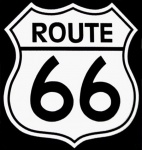 Rolling for Initiative is a weekly column by Scott Thorne, PhD, owner of Castle Perilous Games & Books in Carbondale, Illinois and instructor in marketing at Southeast Missouri State University. This week, Thorne looks at Route 66 and the lessons it teaches about business.
Rolling for Initiative is a weekly column by Scott Thorne, PhD, owner of Castle Perilous Games & Books in Carbondale, Illinois and instructor in marketing at Southeast Missouri State University. This week, Thorne looks at Route 66 and the lessons it teaches about business.Driving out to the GAMA Trade Show this weekend, which means that Internet connections are spotty to say the least. Yes, I know it is much faster to fly but you do not get a feel for the country from thousands of feet in the air. On the ground, even passing by at sixty miles per hour, you get a sense of the country, how people are spending their lives and what is important to them, especially when you get off the interstate and drive the side roads, following what remains of Route 66 for as much as I could.
As a retailer and a marketing instructor, Route 66, "The Mother Road" fascinates me because of the ways in which people along it, from the 1920s to today, use the Road and the travellers along it to make their livings. The businesses along it show emphatically why place, product and promotion are so important to a product or business and price often less so.
For those not familiar with it, Route 66 was the first paved highway to link much of the nation together. Contrary to many people's assumptions, it didn't reach from coast to coast, but originated in Chicago and ran west to Los Angeles. During the 1930's the road served as the primary corridor for people wanting to leave the Dust Bowl of the Midwest for a better life in California (read or watch The Grapes of Wrath, if you haven't already). What happened then was that businesses sprang up alongside the road to serve those travelers: gas stations, motels (or motor courts as they were often called then), restaurants. Since they were right along the road, right where people needed their services, they thrived.
However, as more people saw the success of those first businesses and came to open up businesses of their own, competition grew. Within a one mile stretch in Holbrook, Arizona, there were no fewer than six motels by the end of the 1950s. It was no longer enough just to offer gas, good food, or a room, you had to do something different to stand out from the pack of competitors: either put a giant spaceman in front of your drive in, set up
a petting zoo for the kids, or build your motel rooms in the shape of teepees. The most successful ones promoted themselves far beyond their immediate area, so that when drivers passed by, they would recognize the business and stop. Cline's Corners in New Mexico has billboards over a hundred miles away from the business, alerting drivers that they are getting closer, while Staunton, Missouri's Merrimac Caverns paid painters to travel up and down the highway, painting the Caverns' logo on the sides and roofs of barns.
Unfortunately for many of the Route 66 businesses, change came when Interstate 40 came through and they couldn't adapt. Unable to take advantage of the fast moving traffic, most died. Glenrio, Texas, once the
site of the thriving Texas Longhorn Motel, "The First and Last Motel in Texas," is now just a small cluster of houses. It is possible to compete and survive when drastic change comes (say, like the Internet) but you have
to be willing to adapt and build your business and your brand. And price isn't always the way to do it. That stretch of motels in Holbrook I mentioned earlier? Most offered rooms starting at $23 to $25 per night yet
sat with empty parking lots, while the Motel 6s, Super 8s and Holiday Inns, all later comers and all offering rooms priced much higher, all had much fuller lots. Why? Because just as Cline's Corners and Merrimac Caverns recognized decades ago, customers want the familiar. They still buy the brand.
The opinions expressed in this column are solely those of the writer, and do not necessarily reflect the views of the editorial staff of ICv2.com.


